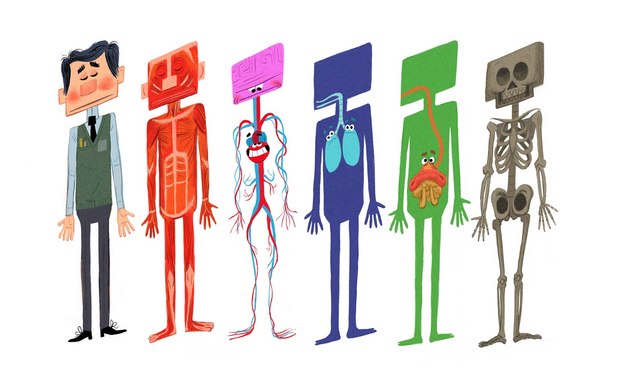Disney’s latest short film uses in-house interpolation software Meander to combine traditional hand-drawn 2D animation with CG technology for a delightful look at the “inner workings” of the typical office staffer.
Inner Workings, the latest short film from Walt Disney Animation Studios, is about a man who goes to work at his soul-crushing job but is constantly distracted by his heart’s desire to get out of the office and live a little. Voiced by storyboard artist Raymond S. Persi (also the voice of Zootopia’s Flash) the delightful short is currently playing in theaters ahead of Moana.
A combination of hand-drawn and CG animation, Inner Workings employs the studio’s proprietary 2D interpolation software Meander, which was previously used in the Oscar-winning shorts Paperman and Feast. Written and directed by Leo Matsuda, Inner Workings co-stars a man and his organs: The heart and its lung buddies are driven by emotion and spontaneity, pulling the rest of the body along in search of instant gratification. The brain is a tedious task-master trying to curb these outbursts of frivolity so its host can focus on his mundane job. Evoking an 80s pre-Internet vibe, the original score for the film was composed by Ludwig Göransson.
Produced as part of the WDAS short film program, Inner Workings was selected from a group of 73 pitches. Matsuda and producer Sean Lurie presented the world premiere screening of the six-minute, 23-second project at this year’s Annecy festival, where it was enthusiastically received, and Inner Workings is now one of 10 titles under consideration for an Oscar nomination in the short film category.
A story artist on Zootopia, Big Hero 6, and the forthcoming sequel to Frozen, Matsuda was nominated for an Annie Award for outstanding achievement in animated feature film storyboarding on Wreck-It Ralph. Lurie, a 10-year Disney veteran, started at DisneyToon Studios, where he produced Tinker Bell and the Lost Treasure before being promoted to vice president of production in 2010, where he oversaw production of films in both the Planes and Tinker Bell franchises. In 2014, Lurie moved over to Walt Disney Animation Studios as vice president of development. He served in studio leadership for Big Hero 6, Zootopia and Moana, in addition to producing the new short.
According to Matsuda, who is of Japanese-Brazilian decent, the film mirrors his own life in many ways. A child of the 80s who grew up without the Internet, Matsuda’s family got a new copy of the Encyclopedia Britannica ever year. He loved these books, especially the sections depicting layers of the human body. “I have the Japanese side of me. It’s very disciplined and logical,” he says. “And I also have the Brazilian side, which loves Carnival and parties. It’s like there’s a civil war going on in my body.”
Matsuda cites directors Jacques Tati and Wes Anderson as cinematic influences on Inner Workings, noting how their style makes the audience feel as if they’re in a play. Paul’s organs were inspired by the work of Ward Kimball, one of Walt Disney’s famed “nine old men.”
Seeking a graphic look for the main character, the filmmakers opted to make Paul’s head square and his body like a stick. Being able to get the mouth to move around on a square head was a challenge. Inspired by stop-motion animation, the production team created two heads, one with a mouth on the front and one with a mouth on the side, allowing them to switch the heads mid-scene to achieve the effect.
For modeling the environment, the filmmakers created a mock-up of the entire environment, but only built what the camera would see so they could be more efficient. To contrast with the squared-off appearance of everything in Paul’s office, the beach characters and the café characters are very curvy, loose and colorful. In order to populate the beach sequences with convincing crowds, two female characters and two male characters were given changes in costuming, hair and scale, allowing for a sense of variety and diversity.
AWN has rounded up a slew of concept art and stills from Inner Workings -- scroll down to see the evolution of environments and character designs that led to the finished film:



























